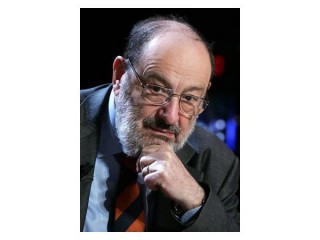
Umberto Eco biography
Date of birth : 1932-01-05
Date of death : -
Birthplace : Alessandria, Piedmont, Italy
Nationality : Italian
Category : Arts and Entertainment
Last modified : 2011-07-12
Credited as : Literary critic, novelist, Il nome della rosa
0 votes so far
Before he was a best-selling novelist, Umberto Eco's reputation rested on his academic writings on language and semiotics (the study of symbols).
An Italian critic, philosopher and historian specializing in medieval history, Eco's first important book was 1959's Art and Beauty in the Middle Ages. During the 1960s he taught at several Italian universities and wrote essays for the avant-garde magazine Il Verri. In the '70s he took a position as a professor at the University of Bologna and furthered his reputation with columns, essays and books such as A Theory of Semiotics (1976).
After receiving a Ph.D. from the University of Turin (1954), Eco worked as a cultural editor for Italian Radio-Television and also lectured at the University of Turin (1956–64). He then taught in Florence and Milan and finally, in 1971, assumed a professorial post at the University of Bologna. His initial studies and researches were in aesthetics, his principal work in this area being Opera aperta (1962; rev. ed. 1972, 1976; The Open Work), which suggests that in much modern music, Symbolist verse, and literature of controlled disorder ( Franz Kafka, James Joyce) the messages are fundamentally ambiguous and invite the audience to participate more actively in the interpretive and creative process. From this work he went on to explore other areas of communication and semiotics in such volumes as A Theory of Semiotics (1976) and Semiotics and the Philosophy of Language (1984), both written in English. Many of his prolific writings in criticism, history, and communication have been translated into various foreign languages, including La ricerca della lingua perfetta nella cultura europea (1993; The Search for the Perfect Language) and Kant e l'ornitorinco (1997; Kant and the Platypus). He edited the illustrated companion volumes Storia della bellezza (2004; History of Beauty) and Storia della bruttezza (2007; On Ugliness), and he wrote another pictorial book, Vertigine della lista (2009; The Vertigo of Lists), produced in conjunction with an exhibition he organized at the Louvre Museum, in which he investigated the Western passion for list-making and accumulation.
The Name of the Rose—in story, a murder mystery set in a 14th-century Italian monastery but, in essence, a questioning of “truth” from theological, philosophical, scholarly, and historical perspectives—became an international best-seller. A film version, directed by Jean-Jacques Annaud, appeared in 1986. Eco continued to explore the connections between fantasy and reality in another best-selling novel, Il pendolo di Foucault (1988; Foucault's Pendulum). His subsequent fictional works include L'isola del giorno prima (1995; The Island of the Day Before) and the illustrated novel La misteriosa fiamma della regina Loana (2004; The Mysterious Flame of Queen Loana).
Author of books:
Novels:
Il nome della rosa (1980; English translation: The Name of the Rose, 1983)
Il pendolo di Foucault (1988; English translation: Foucault's Pendulum, 1989)
L'isola del giorno prima (1994; English translation: The Island of the Day Before, 1995)
Baudolino (2000; English translation: Baudolino, 2001)
La misteriosa fiamma della regina Loana (2004; English translation: The Mysterious Flame of Queen Loana, 2005)
Il cimitero di Praga (2010; English translation: The Prague Cemetery, 2011)
Non-fiction books:
Il problema estetico in San Tommaso (1956 – English translation: The Aesthetics of Thomas Aquinas, 1988, Revised)
"Sviluppo dell'estetica medievale", in Momenti e problemi di storia dell'estetica (1959 – Art and Beauty in the Middle Ages, 1985)
Opera aperta (1962, rev. 1976 – English translation: The Open Work (1989)
Diario Minimo (1963 – English translation: Misreadings, 1993)
Apocalittici e integrati (1964 – Partial English translation: Apocalypse Postponed, 1994)
Le poetiche di Joyce (1965 – English translations: The Middle Ages of James Joyce, The Aesthetics of Chaosmos, 1989)
La Struttura Assente (1968 – The Absent Structure)
Il costume di casa (1973 – English translation: Faith in Fakes: Travels in Hyperreality, 1986)
Trattato di semiotica generale (1975 – English translation: A Theory of Semiotics, 1976)
Il Superuomo di massa (1976)
Dalla periferia dell'impero (1977)
Lector in fabula (1979)
The Role of the Reader: Explorations in the Semiotics of Texts (1979 – English edition containing essays from Opera aperta, Apocalittici e integrati, Forme del contenuto (1971), Il Superuomo di massa, Lector in Fabula).
Sette anni di desiderio (1983)
Postille al nome della rosa (1983 – English translation: Postscript to The Name of the Rose, 1984)
Semiotica e filosofia del linguaggio (1984 – English translation: Semiotics and the Philosophy of Language, 1984)



















